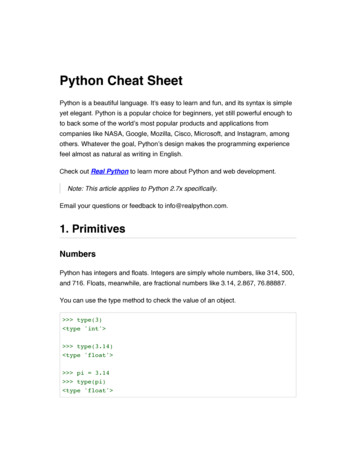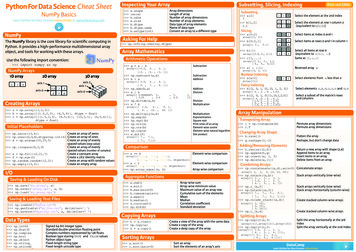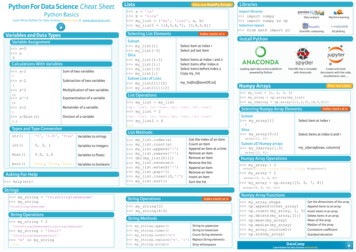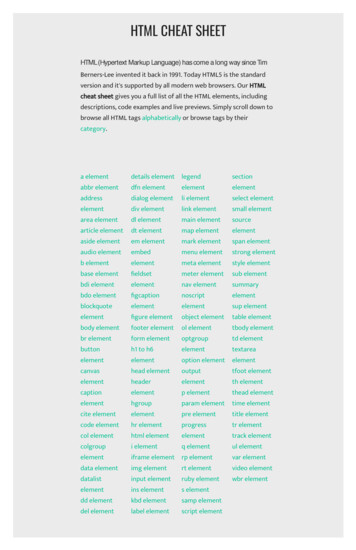
Transcription
Python Cheat SheetPython is a beautiful language. It's easy to learn and fun, and its syntax is simpleyet elegant. Python is a popular choice for beginners, yet still powerful enough toto back some of the world’s most popular products and applications fromcompanies like NASA, Google, Mozilla, Cisco, Microsoft, and Instagram, amongothers. Whatever the goal, Python’s design makes the programming experiencefeel almost as natural as writing in English.Check out Real Python to learn more about Python and web development.Note: This article applies to Python 2.7x specifically.Email your questions or feedback to info@realpython.com.1. PrimitivesNumbersPython has integers and floats. Integers are simply whole numbers, like 314, 500,and 716. Floats, meanwhile, are fractional numbers like 3.14, 2.867, 76.88887.You can use the type method to check the value of an object. type(3) type 'int' type(3.14) type 'float' pi 3.14 type(pi) type 'float'
In the above example, pi is the variable name, while 3.14 is the value.You can use the basic mathematical operators: 6 0 1 9 27 2 12 22 10 1003 33-33/33*33**3num 3num num - 1print numnum num 10print numnum 10print numnum - 12print numnum * 10numWhat happens when you divide 9 by 4? 9 / 42What is the actual answer? 2 remainder 1 right? Or: 2.25In Python 2.7x, when you divide a whole number by a whole number and the
answer is a fractional number, Python returns a whole number without theremainder. In other words, this type of divison rounds the fraction down to thenearest whole number (commonly known as flooring the results).Let's look at 12 divided by 5. If we want to get a fraction, we can just turn one ofthe numbers into a float. 12 / 5.02.4 12 / float(5)2.4There's also a special operator called a modulus, % , that returns the remainderafter integer division. 10 % 31 10 / 33One common use of modulous is determining if a number is divisible by anothernumber. For example, we know that a number is even if it's divided by 2 and theremainder is 0. 10 % 20 12 % 20Finally, make sure to use parentheses to enforce precedence. (2 3) * 525StringsStrings are used quite often in Python. Strings, are just that, a string of characters.
A character is anything you can type on the keyboard in one keystroke, like aletter, a number, or a backslash.Python recognizes single and double quotes as the same thing, the beginning andends of the strings. “string list”‘string list’ ‘string list’‘string list’Now what if you have a quote in the middle of the string? Python needs help torecognize quotes as part of the English language and not as part of the Pythonlanguage. “I can’t do that”“I can’t do that” “He said \“no\” to me”“He said “no” to me”Now you can also join strings with use of variables as well. a “first” b “last” a b‘firstlast’If you want a space in between, you can change a to the word with a space after. a “first ” a b“first last”There are also different string methods for you to choose from as well - likeupper , lower , replace , and count .Upper does just what it sounds like, changes your string to have uppercase
letters. w 'woah!' w.upper()'WOAH!'Lower is just that as well, keeping your string in lower case letters. w 'WOAH!' w.lower()'woah!'Replace allows you to replace any character with another character. r 'rule' r.replace('r','m')'mule'Count lets you know how many times x appears in the string (can be numbers ora string of words as well). numbers ['1','2','1','2','2'] numbers.count('2')3You can also format strings with the format method. "{0} is a lot of {1}".format("Python", "fun!")'Python is a lot of fun!'BooleansBoolean values are simply True or False .Check to see if a value is equal to another value with two equal signs.
10 10True 10 11False "jack" "jack"True "jack" "jake"FalseTo check for inequality use ! . 10 ! 10False 10 ! 11True "jack" ! "jack"False "jack" ! "jake"TrueYou can also test for , , , and . 10 10False 10 11True 10 10True 10 11True 10 10 0False 10 10 11True "jack" "jack"False "jack" "jack"True
2. CollectionsListsLists are containers for holding values. fruits ['apple','lemon','orange','grape'] fruits['apple', 'lemon', 'orange', 'grape']To access the elements in the list you can use the placement in the list as anidicator. This means numbering the items aligned with their placement in the list.But, you must remember that the list starts with 0. fruits[2]‘orange’If the list is longer and you need to count from the end you can also do that. fruits[-2]‘orange’Now, sometimes lists can get long and you want to keep track of how manyelements you have in your list. To find this, use len which is the length function. len(fruits)4Use append to add a new object to the end of the list and pop to remove objectsfrom the end.
fruits.append('blueberry') fruits['apple', 'lemon', 'orange', 'grape', 'blueberry'] fruits.append('tomato') fruits['apple', 'lemon', 'orange', 'grape', 'blueberry', 'tomato'] fruits.pop()'tomato' fruits['apple', 'lemon', 'orange', 'grape', 'blueberry']Check to see if a value exists using in . 'apple' in fruitsTrue 'tomato' in fruitsFalseDictionariesA dictionary optimizes element lookups. It uses keys and values, instead ofnumbers as placeholders. Each key must have a value. You can used a word tolook up a value. words {'apple':'red','lemon':'yellow'} words{'lemon': 'yellow', 'apple': 'red'} words['apple']'red' words['lemon']'yellow'This will also work with numbers.
dict {'one':1,'two':2} dict{'two': 2, 'one': 1} Output all the keys as a list with keys() and all the values with values() . words.keys()['lemon', 'apple'] words.values()['yellow', 'red']3. Control StatementsIF StatementsThe IF statement is used to check if a condition is true.Essentially, if the condition is true, the Python interpreter runs a block ofstatements called the if-block. If the statement is false, the interpreter skips the ifblock and processes another block of statements called the else-block. The elseclause is optional.Let's look at two quick examples.
.thenum 20if num 20:print 'the number is 20'else:print 'the number is not 20' .thenum 21if num 20:print 'the number is 20'else:print 'the number is not 20'number is 20number is not 20You can also add an elif clause to add another condition. .thenum 21if num 20:print 'the number is 20'elif num 20:print 'the number is greater then 20'else:print 'the number is less then 20'number is greater then 20LoopsThere are 2 kinds of loops used in Python. The For loop and the While loop. Forloops are traditionally used when you have a piece of code which you want torepeat n number of times. They are also commonly used to loop or iterate overlists.
colors ('red','blue','green') colors('red', 'blue', 'green') for favorite in colors:.print "I love " favorite.I love redI love blueI love greenWhile loops, like the For Loop, are used for repeating sections of code - but unlikea for loop, the while loop will not run n times, but until a defined condition is met. num 1 num1 while num 5:.print num.num 1.123454. FunctionsFunctions are blocks of reusable code that perfrom a single task.You use def to define (or create) a new function then you call a function byadding parameters to the function name.
def multiply(num1, num2):.return num1 * num2. multiply(2,2)4You can also set default values for parameters. def multiply(num1, num2 10):.return num1 * num2. multiply(2)20Ready to learn more?Visit Real Python to learn more Python and web development. Cheers!
Python is a beautiful language. It's easy to learn and fun, and its syntax is simple yet elegant. Python is a popular choice for beginners, yet still powerful enough to to back some of the world’s most popular products and applications from companies like NASA, Google











